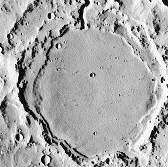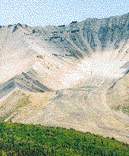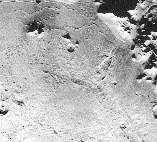Important note: please consider that some ideas expressed in this article have since proved rather pessimistic. For example, it is now considered by many scientists that even under 0 degree Celsius, any ice is topped by liquid water. The temperature estimates have to be corrected also. Indeed, while -60 Celsius is often cited as a maxima, this temperature applies several feet above the ground, and not on the ground itself, where soil heat, reflective phenomena etc., can cause the temperature to be above 0 Celsius.
The newly discovered evidence that extraterrestrial microbes may have once lived in a rock cast off from that planet stirs feelings of awe. But the recent claim also evokes thoughts of Percival Lowell, a well-known American astronomer of the early 20th century, who turned his telescope toward Mars and saw a vast network of canals bordered by vegetation. His suggestion that Mars harbored such lushness had many people believing that the surface of the planet enjoyed conditions not so different from those on Earth. But in the 1960s three Mariner spacecraft flew by Mars and revealed the true harshness of its environment.
Observations from those unmanned probes indicated that Mars has an atmosphere that is thin, cold and dry. This tenuous shroud, composed almost entirely of carbon dioxide, provides less than 1 percent of the surface pressure found at sea level on Earth. The images radioed back during those first fleeting encounters three decades ago were fuzzy and few in number, but they were decidedly more accurate than Lowell's telescopic views. The Mariner cameras showed no canals, no water and no vegetation. They presented only a moonlike surface covered with craters. Sober scientists quickly dismissed any notion that the climate on Mars was sufficiently warm or wet to sustain life.
With its distant orbit - 50 percent farther from the sun than Earth - and slim atmospheric blanket, Mars experiences frigid weather conditions. Surface temperatures typically average about -60 degrees Celsius (-76 degrees Fahrenheit) at the equator and can dip to -123 degrees C near the poles. Only the midday sun at tropical latitudes is warm enough to thaw ice on occasion, but any liquid water formed in this way would evaporate almost instantly because of the low atmospheric pressure.
Although the atmosphere holds a small amount of water, and water-ice clouds sometimes develop, most Martian weather involves blowing dust or carbon dioxide. Each winter, for example, a blizzard of frozen carbon dioxide rages over one pole, and a few meters of this dry-ice snow accumulate as previously frozen carbon dioxide evaporates from the opposite polar cap. Yet even on the summer pole, where the sun remains in the sky all day long, temperatures never warm enough to melt frozen water.
Despite the abundant evidence for cold, dry conditions, the impression of Mars as a perpetually freeze-dried world has been steadily giving way since the Mariner probes first reported their findings. Planetary scientists, who continue to examine the voluminous data from both the Mariner and the later Viking missions of the 1970s, now realize that Mars has had a complex climatic history - one that was perhaps punctuated with many relatively warm episodes. At certain times, huge volumes of water flowed freely across the surface of the planet. Before considering what this astonishing fact means for the possibility of life evolving on Mars or the strategy for the next round of Martian exploration (which is just now getting under way), it is instructive to review how this reversal in the way Mars is perceived came about.
|
Crater lakes can be found on Earth in the depressions left after an impact of an asteroid or comet. The New Quebec Crater is a prime example of the formation of such a lake. A similar body may have once occupied a smooth-floored crater of the Martian highlands, which shows both a terraced inlet (8 o'clock position) and a deeply incised outlet channel (3 o'clock position). |

|
Scrutinizing the Mariner and Viking images obtained from orbit, planetary scientists soon noticed that most old Martian craters (unlike lunar ones) are eroded and that features resembling mudflows occur around almost every large, young crater on Mars. Such muddy "ejecta" probably represent the frozen remnants of a cataclysmic moment in the past when an asteroid or comet collided with the Martian surface, melting a patch of icy permafrost (where water-saturated ground had been frozen) and excavating a large hole that tapped a zone containing liquid water deep underground. By the late 1970s planetologists concluded that a considerable amount of underground ice and water has been present below the Martian surface throughout much of the history of the planet.
Yet not all Martian craters have these muddy flows surrounding them. Smaller craters appear more like their counterparts on the moon, with just streaks of dry ejecta scattered around them. Near the equator of Mars, only craters greater than about four kilometers in diameter display muddy ejecta, but closer to the Martian poles, craters as small as one kilometer across also have relic mudflows. This dependence on latitude arises because the ice-free, surficial layer varies in thickness. This layer extends deeper near the equator (to about 800 meters) than near the poles because the relative warmth of the Martian tropics purges much of the subsurface of frozen water. Hence, near the equator only the impact of bigger objects (that is, those that leave relatively large craters) will burrow down through the upper layer to heat the underlying icy permafrost and release a torrent of mud.
Researchers have since found other indications that a thick substratum of frozen ground exists on Mars. They have also identified evidence that ice once formed on the surface, where it appears to have created characteristic glacial landscapes. These features include bouldery ridges of sediment left by melting glaciers at their margins and meandering lines of sand and gravel deposited beneath glaciers by streams running under the ice (so-called eskers).
Many telltale landforms on Mars resemble frosty sites on Earth. For example, the pitted terrain on Mars corresponds to an earthly equivalent called thermokarst, which forms when the ice contained at shallow levels melts and the ground collapses. The apron-shaped lobes of rocky debris seen on the flanks of some Martian mountains might be rubble-covered glaciers. Or, more likely, they represent "rock glaciers," like the ones that form within the Alaska Range and in the Antarctic Dry Valleys on Earth. These distinctive sloping surfaces result after thousands of freeze-thaw cycles cause the top meter or so of water-soaked ground to creep slowly downhill.
Glacial features and muddy ejecta around craters are not the only examples of water shaping the Martian surface. In some places, sinuous valleys one kilometer wide and many hundreds of kilometers long form large branching networks. Carl Sagan of Cornell University, Victor R. Baker of the University of Arizona and their colleagues suggested in the 1970s that such troughs were created by running water. Other Martian valleys have blunt starting points and short tributaries, characteristics that are typical of erosion by groundwater "sapping." That process, common on Earth, results from the seepage of water from underground springs, which causes the overlying rock and soil to wash away.
Images of Mars also reveal enormous outflow channels etched on the surface. Some of these structures are more than 200 kilometers wide and can stretch for 2,000 kilometers or more. These channels emanate from what is called chaotic terrain, regions of fractured, jumbled rocks that apparently collapsed when groundwater suddenly surged outward. The ensuing floods carved the vast channels, leaving streamlined islands more than 100 kilometers long and gouging cavernous potholes several hundred meters deep. Baker compared the Martian outflow channels to similar, albeit smaller, flood features found on Earth in parts of Oregon and Washington State. Those so-called channeled scablands of the Pacific Northwest formed after a glacier that had dammed a large lake broke open suddenly and caused a catastrophic flood.
The geometry of the Martian outflow channels indicates that water could have flowed along the surface as rapidly as 75 meters per second (170 miles per hour).
Michael H. Carr of the U.S. Geological Survey estimates that the vast quantity of water necessary to create these many enormous channels would have been enough to fill a global Martian ocean that was 500 meters deep, although not all this liquid flowed at one time. One source for that great quantity of water may have been a deep lake in Valles Marineris, a region on Mars partly covered with sedimentary layers that appear to be ancient lake deposits. Water could also have gushed from a large reservoir under ice-impregnated permafrost that had been warmed by heat from the interior of the planet.
Why should such an underground accumulation of water suddenly inundate the surface? Scientists are unsure of the exact cause, but this groundwater might have started to flow after the icy permafrost capping it thinned and weakened, perhaps because of a sudden climate warming, volcanism or tectonic uplift. Perhaps a large meteor impact or quake triggered the cataclysmic dousing. Once water broke through to the surface, carbon dioxide from saturated groundwater - a Martian seltzer of sorts - may have erupted in tremendous geysers, further undermining the stability of the saturated underground layers. The result was to produce chaotic terrain and to unleash floods and mudflows of a magnitude that has rarely, if ever, been matched by any earthly deluge.
|
Rock Glacier An Ocean Away. |

|
Some highland areas on Mars contain extensive systems of valleys that drained into sediment-floored depressions. These lowlands were at one time full of water. The largest of these Martian lakes filled two gigantic impact basins called Hellas and Argyre.
But these lakes may not have been the largest bodies of water on the planet. Research groups led by David H. Scott and Kenneth L. Tanaka of the U.S. Geological Survey and by Jeffrey M. Moore of the National Aeronautics and Space Administration Ames Research Center independently concluded that repeated floods from the outflow channels emptied to the north and formed a succession of transient lakes and seas. We have interpreted many features bordering these ancient basins as marking where glaciers once emptied into these deep bodies of water. Tanaka and Moore believe that thick layers of sediment deposited in these seas now stretch across much of the extensive northern plains. According to several estimates, one of the larger of the northern seas on Mars could have displaced the combined volume of the Gulf of Mexico and the Mediterranean Sea.
Yet even that great body of water may not have been the supreme example: there may have been a Mars ocean. As early as 1973 the late Henry Faul of the University of Pennsylvania raised this intriguing possibility in a paper he romantically entitled "The Cliff of Nix Olympica." Understandably, given the paucity of observations then available, the paper was never accepted for publication. But during the past decade, other researchers, working with information acquired during the Viking missions, have revived Faul's idea.
For instance, in 1989 Timothy J. Parker and his colleagues at the Jet Propulsion Laboratory in Pasadena, Calif., again proposed a northern ocean (arguing that many features in the northern plains looked as if they had resulted from coastal erosion). To enhance prospects for publication, however, they deliberately obscured the provocative thrust of their work with the mundane title "Transitional Morphology in the West Deuteronilus Mensae Region of Mars: Implications for Modification of the Lowland/Upland Boundary." In a subsequent paper, these researchers ventured a more direct title to convey their ideas: "Coastal Geomorphology of the Martian Northern Plains." Motivated in part by such work, Baker and several colleagues (including us) named this hypothetical northern ocean Oceanus Borealis. We calculated that it was possibly four times as large as the Arctic Ocean on Earth, and we proposed a scenario for the actions of the water cycle on Mars that could have accounted for it.
Whereas most planetary scientists now agree that large bodies of water formed repeatedly in the northern plains on Mars, many do not accept that there was ever a true ocean there. Some envision that only a vast, muddy slurry, or mud ocean, existed. In any case, it is clear that huge amounts of water once flowed over the surface of Mars. Yet the fate of that water remains unknown. Some of it may have percolated into the subsurface and frozen in permafrost. Some may have frozen in place and might now stretch across much of the floor of the northern plains, hidden by a mantle of dust and sand. Some water may simply have evaporated, to be later lost to space or deposited as snow at the poles.
Although images of the landforms left by ancient glaciers, river valleys, lakes and seas are strong testament that Mars was once rich in water, evidence comes from other sources as well. Earth-based spectroscopic measurements of Mars reveal the presence of clay minerals. Even more directly, the two landers that set down on the surface during the Viking program analyzed Martian soil and found that it probably contains 10 to 20 percent salts. Martian rocks, like those on Earth, react to form salt and clay minerals when exposed to water. But such chemical weathering probably cannot occur under the cold and dry conditions that now reign on Mars.
Some scientists have also studied Martian rocks found here on Earth. These rare samples of the Martian surface were blasted into space by the impact of an asteroid or comet and later fell to Earth as meteorites. Allan H. Treiman of the Lunar and Planetary Institute in Houston and James L. Gooding of the NASA Johnson Space Center have shown in the past several years that minerals in some of these so-called SNC meteorites were chemically altered by cool, salty water, whereas others were affected by warmer hydrothermal solutions. Their conclusions imply that Mars once had a relatively warm, wet climate and may have had hot springs. Just perhaps, conditions were right for life.
That possibility inspired David S. McKay of the nasa Johnson Space Center and his colleagues to examine an SNC meteorite for signs of ancient Martian life. Although their conclusion that fossil microbes are present is open to debate (and a vigorous one is indeed going on), the composition of the rock they studied - with fractures filled by minerals that probably precipitated from an aqueous solution - indicated that conditions on Mars a few billion years ago would have been compatible with the existence of life.
In agreement with this assessment, many atmospheric physicists had already concluded that Mars has lost immense quantities of water vapor to space over time. Their theoretical calculations are in good accord with measurements made by various Soviet space probes that showed oxygen and hydrogen atoms (derived from breakdown of atmospheric water exposed to sunlight) streaming away from Mars. The continuous loss of these elements implies that Mars must once have had all the water needed to fill an Oceanus Borealis.
But water was not the only substance lost. Recently David M. Kass and Yuk L. Yung of the California Institute of Technology examined the evolution of carbon dioxide - a potent greenhouse gas - in the atmosphere of Mars. They found that over time an enormous quantity of carbon dioxide has escaped to space. That amount of gaseous carbon dioxide would have constituted a thick Martian atmosphere with three times the pressure found at the surface of Earth. The greenhouse effect from that gas would have been sufficient to warm most of the surface of Mars above the freezing point of water. Thus, from this perspective, too, it seems quite plausible that the climate on Mars once was much warmer and wetter than it is today.
Yet many questions remain about how water might have arranged itself on the surface of Mars: Was there actually an ocean? Did water shift rapidly between different reservoirs? When and for how long was Mars wet? Although the absolute timing of these events remains unknown, most researchers believe that water sculpted the surface of Mars at many intervals throughout the history of the planet. The constant loss of water and carbon dioxide from the atmosphere suggests that early epochs on Mars (that is, billions of years ago) may have been especially warm and wet. But some balmy periods may also have been relatively recent: Timothy D. Swindle of the University of Arizona and his colleagues studied minerals in an SNC meteorite created by aqueous alteration and determined that they formed 300 million years ago - a long time by human standards but only a few percent of the age of the 4.6-billion-year-old solar system. Their result was, however, accompanied by a considerable degree of uncertainty.
The duration of the wet periods on Mars is also difficult to gauge exactly. If the eroded Martian landscapes formed under conditions typical of terrestrial glacial environments, more than a few thousand but less than about a million years of warm, wet climate were required. Had these conditions endured substantially longer, erosion would have presumably erased all but traces of a few impact craters, just as it does on Earth.
This limitation does not apply to the earliest history of the planet, billions of years ago, before the craters now visible had formed. A young Mars may well have had vigorous erosion smoothing its face. But eventually, as the planet slipped toward middle age, its visage became cold, dry and pockmarked. Only scattered intervals of warmth have since rejuvenated the surface of the planet in certain regions. Yet the mechanism that causes Mars to switch between mild and frigid regimes remains largely mysterious. Scientists can now venture only crude explanations for how these climate changes might have occurred.
|
ESKERS are sinuous ridges made up of sand and gravel deposited by streams that formerly ran underneath a sheet of ice. They appear to exist on the floor of the Argyre basin on Mars, indicating that melting glaciers once covered the area. |

|
One hypothesis involves shifts in obliquity, the tilt of the spin axis from its ideal position, perpendicular to the orbital plane. Mars, like Earth, is now canted by about 24 degrees, and that tilt changes regularly over time. Jihad Touma and Jack L. Wisdom of the Massachusetts Institute of Technology discovered in 1993 that, for Mars, the tilt can also change abruptly. Excursions of the tilt axis through a range of as much as 60 degrees may recur sporadically every 10 million years or so. In addition, the orientation of the tilt axis and the shape of the orbit that Mars follows both change cyclically with time.
These celestial machinations, particularly the tendency of the spin axis to tilt far over, can cause seasonal temperature extremes. Even with a thin atmosphere such as the one that exists today, summer temperatures at middle and high Martian latitudes during periods with large obliquity could have climbed above freezing for weeks on end, and Martian winters would have been even harsher than they are currently.
But with sufficient summer warming of one pole, the atmosphere may have changed drastically. Releases of gas from the warmed polar cap, from seltzer groundwater or from carbon dioxide- rich permafrost may have thickened the atmosphere sufficiently to create a temporary greenhouse climate. Water could then have existed on the surface. Aqueous chemical reactions during such warm periods would in turn form salts and carbonate rocks. That process would slowly draw carbon dioxide from the atmosphere, thereby reducing the greenhouse effect. A return to moderate levels of obliquity might further cool the planet and precipitate dry-ice snow, thinning the atmosphere even more and returning Mars to its normal, frigid state.
This theory of climatic change needs to be tested, but new observations and fresh insights will undoubtedly come from a decade-long series of unpiloted spacecraft that will next visit Mars. The expeditions begin this month with the launch of American and Russian probes. This program of exploration had been slated to conclude in 2005 with the return of Martian rocks. But the discovery of what may be fossil microbes in an SNC meteorite has sparked thoughts of obtaining Martian samples sooner so that scientists can better evaluate whether microorganisms existed on Mars several billion years ago - or even more recently.
The American spacecraft soon to be under way include Mars Pathfinder and Mars Global Surveyor. Pathfinder will land on a bouldery plain of an outflow channel that once fed an ancient sea. Although not equipped to test directly for signs of life, this lander will release a small roving vehicle to explore the local environs. Surveyor will take pictures from orbit that can resolve features that are just a few meters across. Measurements from this orbiter will also allow scientists to make detailed topographic maps and to search for icy deposits as well as new evidence of ancient glaciers, lakes and rivers. Information gathered by these next missions should give scientists a clearer picture of what Mars looked like during its last episode of warmer climate, perhaps 300 million years in the past.
By 300 million years ago on Earth, amphibians evolved from fish had crawled out of the sea and inhabited swampy coastlines. Might other complex creatures have flourished simultaneously along Martian shores? The basic conditions for life may have existed for a million years late in Martian history - perhaps much longer during an earlier period. Were these intervals conducive for organisms to evolve into forms that could survive the dramatic changes in climate? Could Martian organisms still survive today in underground hot springs? The next decade of concentrated exploration may provide the definitive answers, which, if positive, would mark an intellectual leap as great as any in human history.
|
TEARDROP-SHAPED HILLS, sculpted by floodwaters of glacial Lake Missoula, are found in the channeled scablands of eastern Washington State (top). Similar streamlined hills dot the floor of outflow channels on Mars, commonly forming behind raised crater rims (bottom). |
 Credit: Victor R. Baker  Credit: NASA |
"Ancient Oceans, Ice Sheets and the Hydrological Cycle on Mars." V. R. Baker, R. G. Strom, V. C. Gulick, J. S. Kargel, G. Komatsu and V. S. Kale in Nature, Vol. 352, pages 589-594; August 15, 1991.
"Ancient Glaciation on Mars." J. S. Kargel and R. G. Strom in Geology, Vol. 20, No. 1, pages 3-7; January 1992.
"The Ice Ages of Mars." J. S. Kargel and R. G. Strom in Astronomy, Vol. 20, No. 12, pages 40-45; December 1992.
"Coastal Geomorphology of the Martian Northern Plains." T. J. Parker, D. S. Gorsline, R. S. Saunders, D. C. Pieri and D. M. Schneeberger in Journal of Geophysical Research E (Planets), Vol. 98, No. 6, pages 11061-11078; June 25, 1993.
Life on Mars - resources from the Federation of American Scientists
JEFFREY S. KARGEL and ROBERT G. STROM have worked together on various projects in planetary science for over a decade. Kargel met Strom soon after beginning graduate studies at the University of Arizona, where he received a doctorate in planetary sciences in 1990. Kargel remained at the University of Arizona's Lunar and Planetary Science Laboratory for two years doing postdoctoral research on the icy moons of the outer solar system and then joined the U.S. Geological Survey's astrogeology group in Flagstaff. Strom began his career working as a petroleum geologist, but he became involved in lunar exploration efforts during the 1960s and joined the faculty of the University of Arizona, where he continues to teach and conduct research. He has participated on National Aeronautics and Space Administration science teams assembled for the Apollo program, for the Mariner missions to Venus and Mercury, and for the Voyager missions to the outer solar system.